HOOKED ON FISH
Messing about in boats with the Bartho Brothers
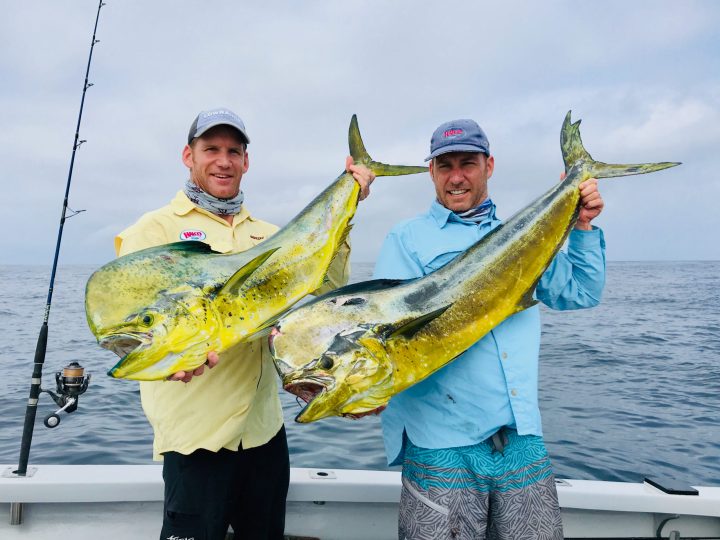
The name Bartho’s is synonymous with fresh fish. Time to bait the brothers, get hooked by some chef tips and trawl for new ideas inspired by their catch. Sceptical? Read on.
My father taught me how to fish. Judging from old photos, I must have been five or six when he bought me my first rod with a coffee-grinder reel and started taking me to Durban harbour on Sunday mornings. There we would bait up, often with rolled-dough balls, sometimes with bits of shrimp. He taught me to cast, to strike when I felt a distinctive nudge, to administer a quick death whack to anything caught and deemed edible.
He was a man of few words, while, as an excruciating introvert, my world lived loudly inside my head. I wonder if he ever guessed how much of a gung-ho buzz of satisfaction it gave me, the feeling of mastery that came with skillfully killing, slitting open, gutting and scaling our fish that we would take home and he would fry up in butter till the tail and skin were crispy. And serve for supper with a squeeze of fresh lemon. So he and I could pick with our fingers at the chewy outer bits and the sweetly delicate inner flesh. And my mother could complain about bones, which he would dutifully have tried to remove from her bits. So he could grumble, “your mother would find a bone in scrambled eggs”.
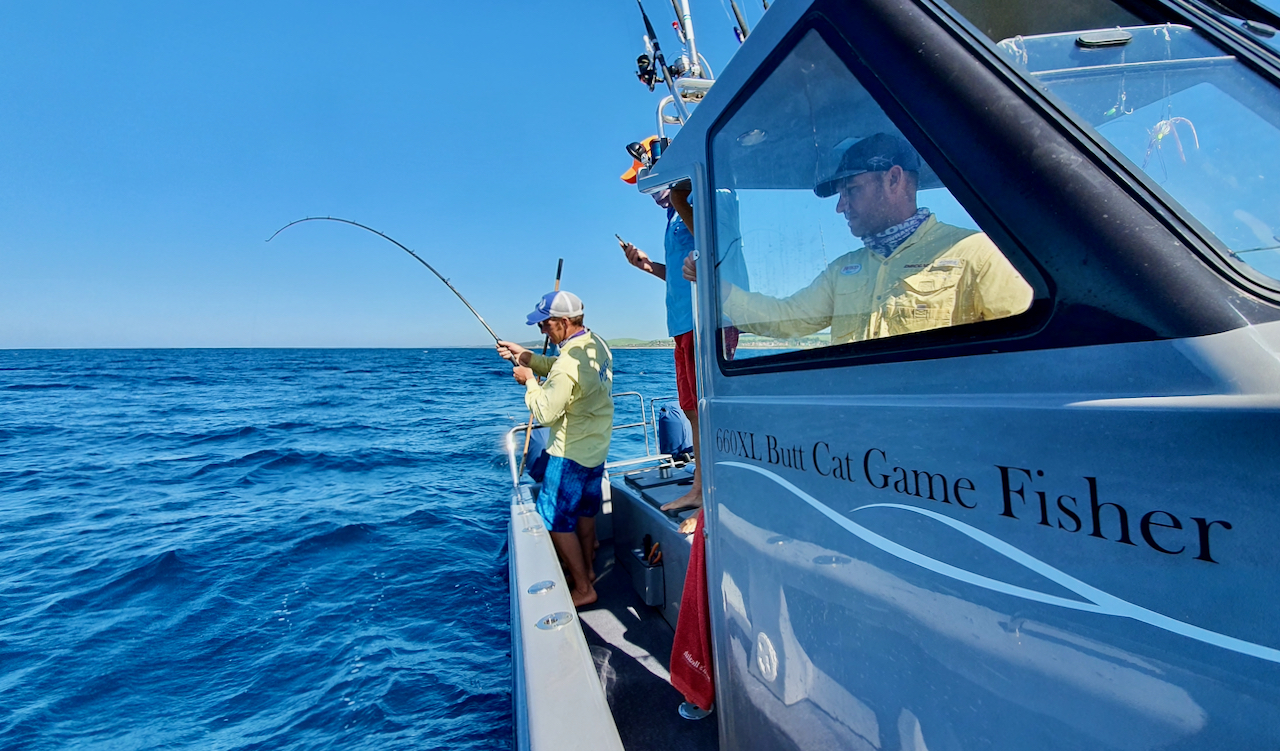
Brett Bartho fishing and Daryl Bartho driving their new custom boat. (Photo: Supplied)
This came back to me last week during a conversation with Brett Bartho, the younger brother and fishing partner of Daryl Bartho. The Bartho brothers, both former fishing champs and paddling champs, are the co-founders of Bartho’s Fish Company in Durban North. Tuna, barracuda aka king mackerel, kob, dorado, slinger, snapper, hake, wahoo. Just some of their fish that have made it so far onto my life-during-coronavirus menu.
Unbeknown to the brothers (although I may by now have told them), on many a night they have been responsible for making my numbered-shades-of-lockdown delicious. For which I feel glad, tinged with sad, imbued with some guilt at my good-fish fortune (in the face of our growing crisis of poverty).
“How would you describe your attitude to fish?” I ask when I meet up with him at the shop. Through lockdown I have watched little videos on the Bartho’s Fish Co Facebook page, and the brothers’ timelines, of the pair of them and their crew out on the ocean waves, fishing. Often paying what they call “tax” as lazy and clever (yes, I am anthropomorphising — with good reason) sharks wait for a snagged pelagic (deep ocean) game fish to tire. So they can eat without all the effort of catching the fish themselves.
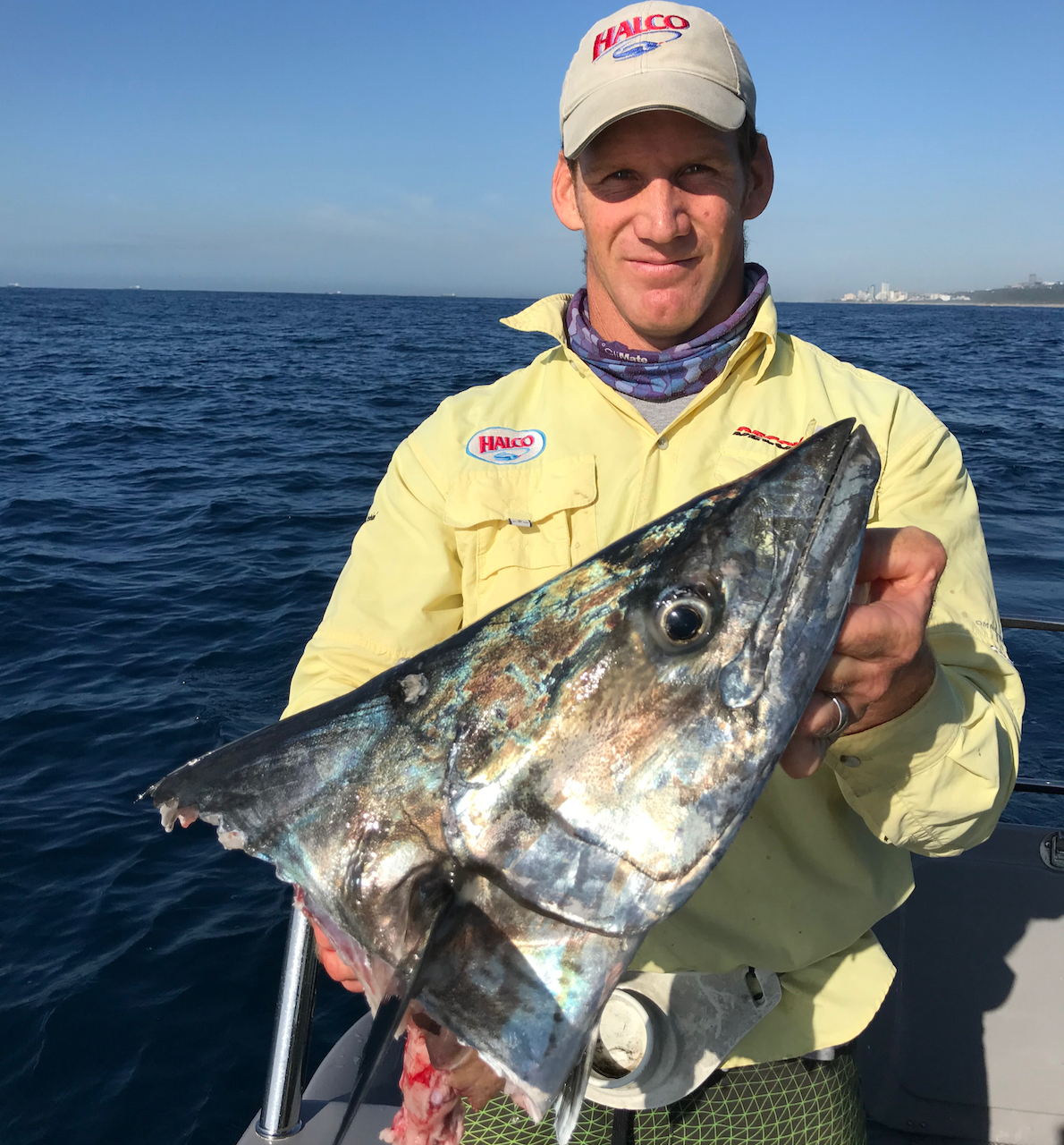
Daryl Bartho paid his tax to a shark on this one. (Photo: Brett Bartho)
Sharks have even been known to hang out under the boat, Brett tells me. Waiting. In one video, you watch this tranquil scene-from-the-depth. This epic fish being slowly edged up, up, up. Then suddenly, in a flash, the shark strikes. Yum. Lunch. And a ripped and severed fish head is all that lands on the boat.
“I live for fish,” Brett Bartho says.
He goes on to tell me that one of the things he learnt from his grandfather, who taught him and his brother to fish when they were younger than I was when my dad taught me, was that catching a fish, killing it and eating it go together.
He is dubious about the sport fishing practice of catch-and-release, which can hurt the fish. Better to target certain species and the right size. Which is what they do as commercial fishermen, these days from their new (as of December) custom-built craft that was two years in construction and designed for deeper (further out) and longer (at sea) fishing. Following best practices and guidelines. With all the fish they catch killed right away and as ethically as possible. Either using a blunt baton to stun. Or, “You brain it with a sharp blade, to kill the fish instantly.”
This is part of the ikejime method (click on the word to read more), considered fastest and most humane. Best also for preserving the quality, texture, flavour and aging potential of a fish. “We use it on certain species where it is easier to do,” he says.
In either case, no fish is left gasping for air. In any case, the fish is then sustained in a slurry of ice.

Brett Bartho’s king mackerel on the braai. (Photo: Brett Bartho)
“What’s your favourite fish recipe?” I ask him, given that all their fish caught is destined for somebody’s table.
“I love doing king mackerel in a beer batter with some rosemary,” he says.
“I basically get the fish cut into medallions with the skin and blood line removed. I make my batter with any type of lager by mixing in cake flour until I get a nice thick consistency. I then add the rosemary into the batter mixture.
“I lightly season the pieces of fish with coarse salt and pepper, dust them in plain flour, dip them for a coating of thick beer batter and shallow-fry in coconut oil in a pan until golden brown and crispy. I normally serve this with sweet potato and butternut wedges done in the air-fryer. Or with a salad if it’s summer.”
What about a family favourite, thinking of his two young sons (and his brother’s two young daughters) who are already learning to love fish and fishing?
“We try and eat fish every second night,” he says. Different fish prepared different ways.
“A great thing is the short preparation and cooking time. For the kids a white fish such as hake, dorado, king mackerel or line fish (slinger, soldiers, etc) cut into little pieces, dusted in a simple mix of breadcrumbs and flour with a little fish spice to give a battered look is a great way to get them into eating fish and staying healthy.”

Simply sashimi with avo in my kitchen. (Photo: Wanda Hennig)
And: “We love our sashimi.” Especially when cut from their export grade tuna, their weekly imported Norwegian salmon consignments or “when we’ve landed a nice big fatty king mackerel on our own commercial boat”. The key, he says, is the freshness and the fat content “that gives it a creamy, melt-in-your-mouth taste. Even my three-year-old son loves sashimi.”
And sometimes he will braai his fish. “Cape salmon (geelbek) and king mackerel are favourites. The salmon because it is beautiful meaty, juicy and a big-flaking fish.”
He recommends taking fish fillets with the skin on and rubbing olive oil on the skin side. Seasoning the fleshy side with coarse salt and pepper and smearing it with a coriander or basil/coriander pesto. “Cook over hot coals for 3/4 of the cooking time with the skin facing down then flip to grill the fleshy side.”
King mackerel he likes to do as a whole side or a big fillet, depending on the size. “Keep the skin on and rub the fillet with olive oil on both sides, season the fleshy side with coarse salt and pepper and a sprinkle of fish spice or seafood rub.
“I make a mixture of a little bit of olive oil, butter, fresh chopped garlic and lemon juice. This I use to baste the fish while it’s cooking over medium to hot coals.” Dorado and kob, he says, are great alternatives.
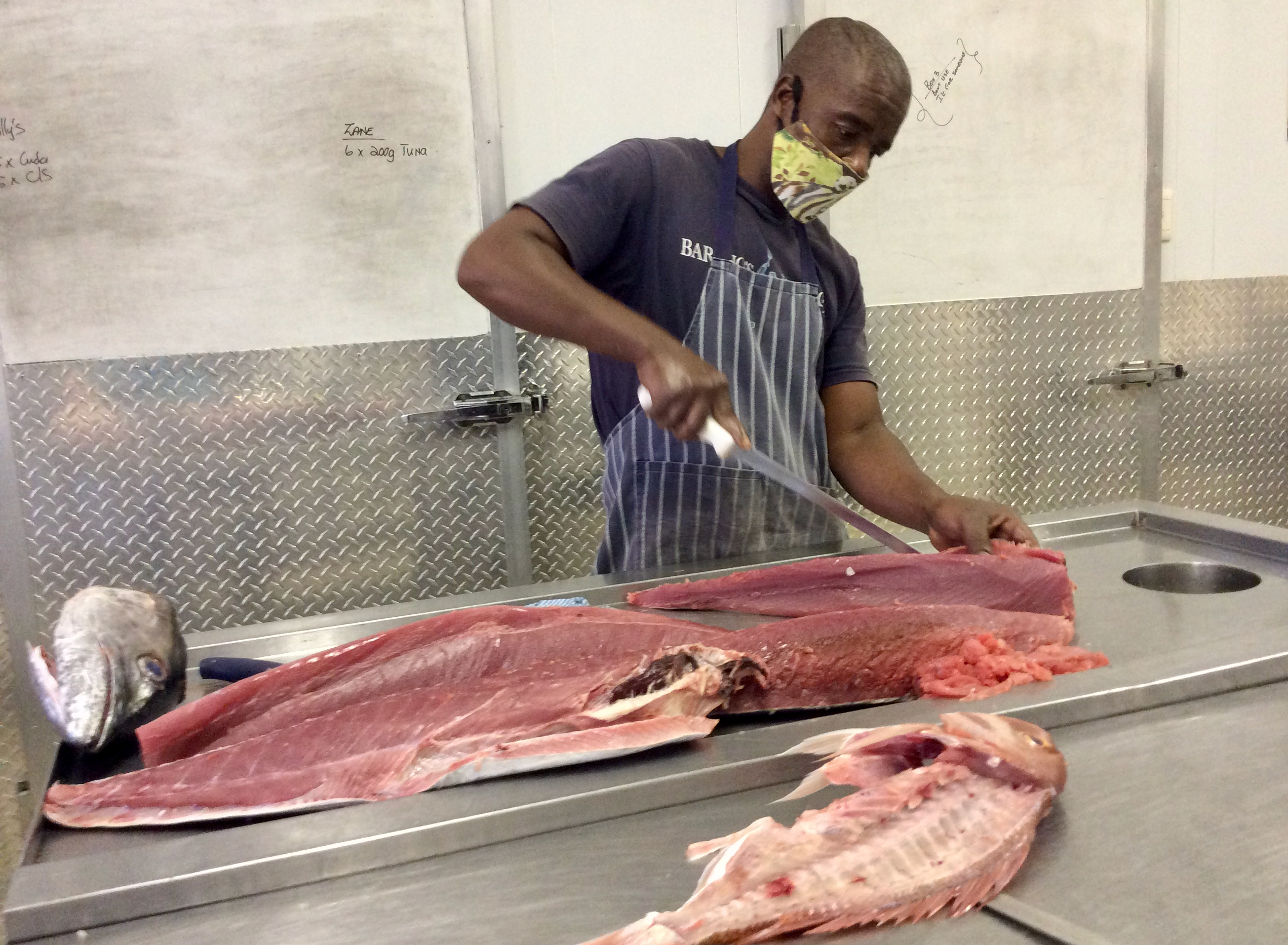
Master filleter Zakhe Nxumalo in action in the old shop. (Photo: Wanda Hennig)
Until last week and for 10 years before that, you had to know the precise location of the Barthos’ fish shop or be doomed to the fate of the optimistic angler and the fish that got away. There was no signage to point you to the unobtrusive driveway off usually-busy Mackeurtan Avenue leading to the tucked-away fishmonger. Proof that fresh fish, fresh fish, fresh fish is more of a statement than location, location, location? At least if your reputation precedes you and you maintain it.
Daryl and Brett — who sold the second of two ski-boats won in consecutive years in fishing contests to raise the money to open the store — have finally moved to a visible spot across the street. With signage. Easy to find. Easy to see.
They are there with the rest of the Bartho team including their mom, Sandy Kruger, and Zakhe Nxumalo, expert filleter and Daruma-trained sushi chef (Durban’s erstwhile high-end Japanese sushi restaurant), both of whom were there when I last wrote about them 10 years back.
The brothers (there is a third, Wesley, working overseas as fleet captain on super yachts) grew up in Empangeni and Richards Bay. It was back in 2003, when Daryl needed to earn a living while training 24/7 in an attempt to earn a place in the Olympics paddling squad (he missed Sydney by a couple of hundredths of a second), that commercial fishermen friends in Richards Bay suggested he start buying from the boats and selling export quality fish (not quite big enough to send overseas) to restaurants.
It was work he could do part-time with minimal disruption to his training schedule.
By the time the brothers left school, both had paddled internationally several times. Back in 2001 as a junior, Brett won a bronze at the World Marathon Champs. The year they opened their shop he was ranked top in the country in deep sea fishing from a paddle ski, which is deemed super-eco friendly: no engines and minimal impact on the beach.
Now, as then, their lives are dictated by the weather. In summer their days can start as early as 2am to get the boat and crew to the beach, pre-dawn, to launch. Some nights, by the time boat and crew and catch are home and dry and sorted and they’re ready to hit the sack, it’s 11pm. “After a few days of four hours sleep, it hits you,” he laughs. Affable. Candid.
“We try as an average to catch 2 tons, that’s 2,000kg, of fish a month off our commercial boat. That’s weather permitting, of course,” he says. “In February this year we could only fish five times and we got 660kg. May was a really good month. We fished 18 times and got 1.9 tons.”

A fishy selection in the store. (Photo: Wanda Hennig)
Having the freshest fish — they’d like to think “in South Africa” — is what they have long been known for. Tuna, dorado, slinger, cob, snapper, musselcracker, ‘cuda: you name it, if they’re biting and it’s the season. Plus the fresh Norwegian salmon they fly in and assorted top-quality frozen seafood you won’t get never-frozen (prawns, crays) unless you land them yourself. Then a few things like rollmops, smoked salmon, kippers, fish stock from boiled fish heads, fish cakes from the scrapings and various condiments that go with fish.
The quality of their fish is what they were known for when they opened. Still now. And don’t just take my word for it. Any number of top-restaurant chefs will confirm that Bartho’s fish takes the cake. Make that the bait?
“Bartho’s fish? We use it all the time. At least we did back when we were still open for business and we most certainly will be using them again. Best, freshest fish in town, absolutely,” says Shaun Munro, executive chef Southern Sun Elangeni Maharani.
“I love Bartho’s fish. The quality. The freshness. Knowing how it’s caught,” says Kayla-Ann Osborn, erstwhile top KZN chef who started last week as head chef at the Delaire Graff Restaurant in Stellenbosch.
“Barthos sells the freshest fish in Durban,” volunteers Themba Mngoma, banqueting sous chef at Southern Sun Elangeni & Maharani, when I call to ask him if he perhaps used their fish for King Shaka’s Skepticism, the dish he created for a private heritage dinner when he was freelancing.

Top grade swordfish: note bloodline and fat content. (Photo: Facebook)
“I’m pretty basic with my fish,” Osborn tells me when I ask her to share fish tips. “I like to just cook fish with butter and add a little lemon at the end.
“I cook it crispy-skinned using quite a lot of butter, which means there’s always juices and stuff that come out, which I save because obviously it’s got all the stock in it and makes the most amazing sauces.
“I also am quite focused on using the whole fish. So I serve fish collars [what Bon Appétit calls “the spareribs of the ocean”], which I debone and normally deep-fry crispy.
“Then another thing I use a lot is fish cheeks. We get big fish on the South Coast. (She grew up in Scottburgh, where her mom lives, and where she was in lockdown before driving to Stellenbosch.) You can debone the cheeks (follow the link to see how) and they are delicious. Somewhat like a chicken oyster but a fish one.
“Then my favourite, favourite part of the fish… I was very lucky to spend a couple of days in San Sebastián in the Basque region in Spain. Their traditional dish is called kokotxas — it’s basically the throat area of the fish. You get them in all the fishmongers there and even the Michelin-star restaurants.”
Osborn suggests I Google Australian chef Josh Niland, who wrote The Whole Fish Cookbook and who “can debone a fish and break out pieces in ways that are incredible”. I do. And watch him. And suggest you do too.
“Another thing he does is dry age his fish, which I have also been doing and it works beautifully. You’ve got to get really high quality fish so I would use Bartho’s fish, for example, because I know how it’s caught. You hang them in a very dry fridge for anything from two days to two weeks, depending on whether it’s a fatty fish or not. And what happens is, the flesh goes white, white, white when you cook it and the skin goes crispy, crispy, crispy ‘cause it’s dried out. Delicious.”
Killing the fish using the ikejime method, to avoid stress, is key if a fish is to be dry-aged.

King Shaka’s Scepticism. Chef Themba Mngoma’s fish and tripe heritage dish. (Photo: Innocent Khumalo)
So, “King Shaka’s Scepticism”? The fish dish at the heritage dinner? “It’s well known that King Shaka was sceptical about eating fish and I thought diners might be sceptical about eating a tripe and fish combination,” Mngoma chuckles. I catch him at home with his two kids, being house-husband as he waits for the hotels to reopen. His wife, also in hospitality, is back at work.
“When cooking fish, you might poach, fry or grill. The main thing with good fish is keep it simple. You don’t want to make it spicy. You don’t want to dilute its essence. You want the flavour of the fish.”
Usually he will pan-fry his fish, skin side down for 80 percent of the time, the skin lightly salted to crisp it. Then flip to finish. Kingklip and hake are favourites. “Fresh hake is so good. Very different from frozen hake.”
He sometimes uses olive oil but “it loses its health benefits when it heats up so I think you’re wasting your money.” Nothing wrong with regular oil. And he advocates the subtlety of white pepper over the intensity and “overtaste” of black ground pepper if it is quality fish. “I normally throw butter in at the end, for flavour.” If he wants a sauce he might simply reduce white wine, add butter, lemon and a little cream to create a simple lemon beurre blanc.
Talking fish with Mngoma triggers memories of his mom’s version of convenience food: tinned Lucky Star served with pap or rice. And also, fishing with a hand-line in a river on what was then a rural part of Umlazi. “Boys being boys, we’d go to the river, where we weren’t allowed to go because our moms’ considered it dangerous. We’d catch fish, make a fire and cook them and eat them before we got home. Couldn’t take them home or they’d know where we’d been.”
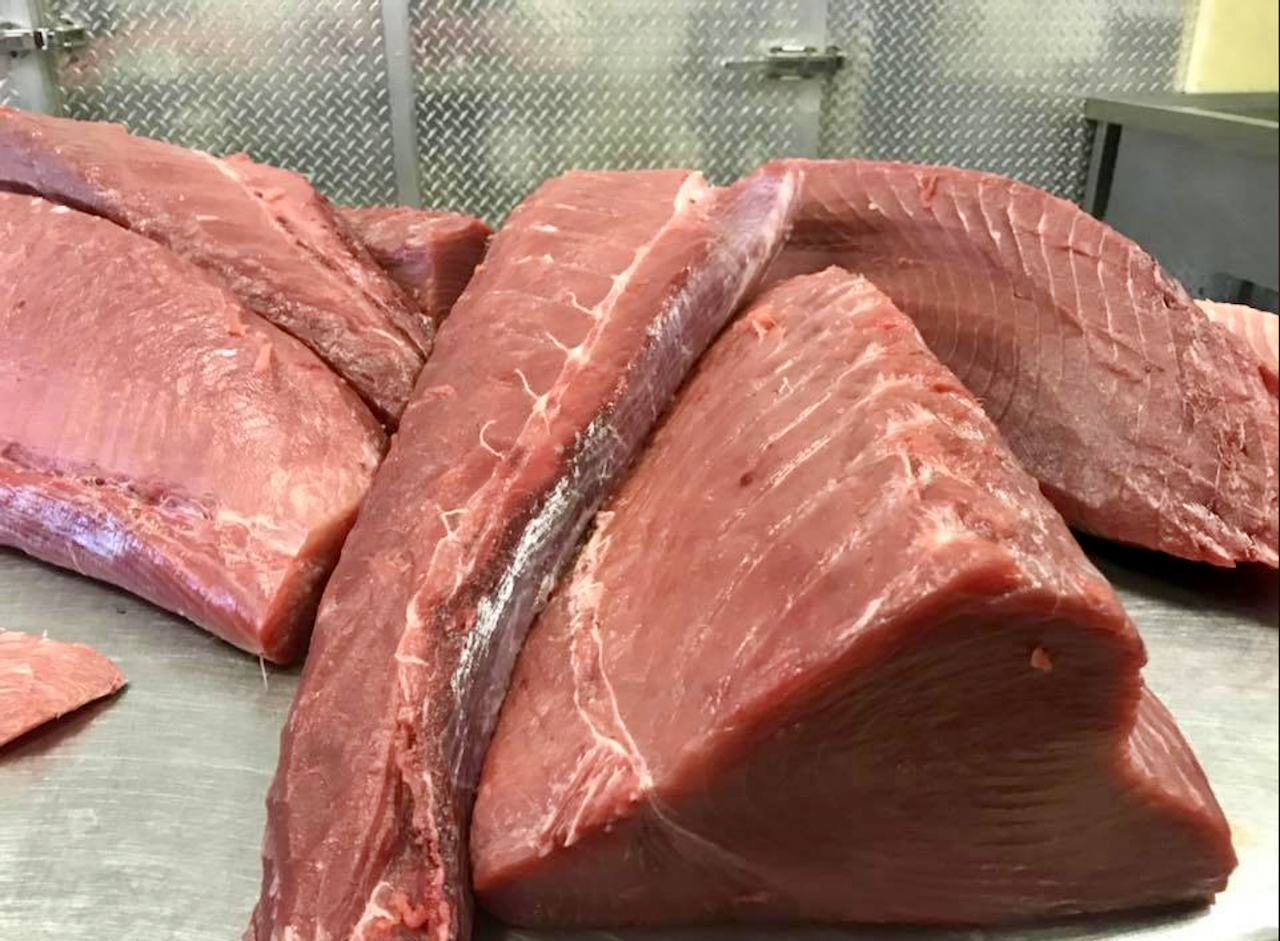
Top quality tuna: why restaurants and chefs love their fish. (Photo: Facebook)
Daryl and Brett and their families were in Europe, snowboarding in France as guests of their brother, when the virus hit. They came back and went into two weeks’ isolation. And into shock.
Restaurants that had taken their fish, sold their fish to customers, been paid for the fish — didn’t pay them. “We’re honest guys. We push hard. Our service is good. We run a tight ship — eat our fish and veggies at home; seldom out. We’re a small business and over the years have tried to keep streamlined with a small dynamic team. That’s how we’ve survived,” says Daryl.
I’ve asked him how they coped, having heard they’d been left high and dry by many.
“We’re sympathetic. But it seemed hugely unfair,” he says bluntly. “Customers pay for the meal so the fish has been paid for. Not like they were sitting with our fish.
“I hear of people who haven’t paid us buying new cars, doing big housing renovations. That’s not cool.”
Conversely, “some have started chipping away”.
They had sold their previous commercial fishing boat, having switched to the new custom one. “The guy we sold it through didn’t want to give us our money.”
Eventually, after pushing, they got that R100,000. They paid the Norwegian salmon guy. They did a lot of damage control working from home by phone during quarantine. “Our priority was to pay our suppliers and staff. When we went into lockdown everyone had been paid. We owed nothing.
“We feel very strongly, when you place an order, you make a commitment – you know you have to pay.”
As an essential service they were able to fish through lockdown. And survived that way. “Eight months ago we were thinking of closing the retail side of our business to put more energy into wholesale. Thankfully we didn’t or we wouldn’t have been in business now.”
Under lockdown, with people staying home and cooking at home, their retail business experienced a mini-boom.
Two years ago they sold two ski boats and bought a warehouse for the wholesale side of the business, which for 10 years they operated, with difficulty, from behind the retail space. They are now set up there for wholesale as well as in the new retail space. Their grandfather, who inspired all this with those early fishing lessons, would be proud to know how it’s all come together this month.
And my early fishing lessons from my dad? They stood me in good stead for many a year. Thinking back to beating at their own game the three neighborhood boys I went harbour fishing with on holidays from boarding school in my teens. And combi-camping at a deserted spot on Namibia’s Skeleton Coast much later. One of our party of four women grabbed the only rod and waded in to fish. Then couldn’t or wouldn’t handle the kill-and-clean essentials so we could braai our fish and eat.
There were other times too. Until one day some years back it dawned on me that I didn’t want to do the dirty on fish any more. But I did still want to eat them. And thanks to these Bartho guys, more than ever before and right here in lockdown, I am. DM/TGIFood
Wanda Hennig is a food and travel writer based in Durban. She has worked on newspapers and magazines in South Africa and the San Francisco Bay Area and freelanced extensively. She is author of Cravings: A Zen-inspired memoir…. Reach her via her website wandahennig.com



















 Become an Insider
Become an Insider